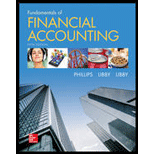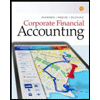
Concept explainers
Reporting Stockholders' Equity and Determining Dividend Policy
Incentive Corporation was authorized to issue 12,000 shares of common stock, each with a $1 par value. During its first year, the following selected transactions were completed:
- a. Issued 6,000 shares of common stock for cash at $20 per share.
- b. Issued 2,000 shares of common stock for cash at $23 per share.
Required:
- 1. Show the effects of each transaction on the
accounting equation. - 2. Give the
journal entry required for each of these transactions. - 3. Prepare the stockholders’ equity section as it should be reported on the year-end
balance sheet . At year-end, the accounts reflected a profit of $100. - 4. Incentive Corporation has $30,000 in the company’s bank account. What is the maximum amount of cash dividends the company can declare and distribute?
1.
To show: The effects of each transaction on the accounting equation.
Explanation of Solution
Accounting equation:
Accounting equation is an accounting tool expressed in the form of equation, by creating a relationship between the resources or assets of a company, and claims on the resources by the creditors and the owners. Accounting equation is expressed as shown below:
- a. Issued 6,000 shares of common stock for cash at $20per share.
| Assets | Liabilities | Stockholders’ equity | |||
| a. | Cash | +120,000(1) | No effect | Common stock Additional paid-in capital common |
+6,000(2) +114,000(3) |
Table (1)
- There is an increase in the asset (cash) by $120,000.
- There is an increase in the stockholders’ equity (Common stock) by $6,000 and increase in the additional paid in capital by $114,000.
Working note:
Calculate the amount of cash:
Calculate the amount of common stock:
Calculate the amount for additional paid in capital:
- b. Issued 2,000 shares of common stock for cash at $23per share.
| Assets | Liabilities | Stockholders’ equity | |||
| a. | Cash | +46,000(4) | No effect | Common stock Additional paid-in capital common |
+2,000(5) +44,000(6) |
Table (1)
- There is an increase in the asset (cash) by $46,000.
- There is an increase in the stockholders’ equity (Common stock) by $2,000 and increase in the additional paid in capital by $44,000.
Working note:
Calculate the amount of cash:
Calculate the amount of common stock:
Calculate the amount for additional paid in capital:
2.
To prepare: The journal entry for the given transactions.
Explanation of Solution
Journal:
Journal is the method of recording monetary business transactions in chronological order. It records the debit and credit aspects of each transaction to abide by the double-entry system.
Prepare the journal entries:
- a. Issued 6,000 shares of common stock for cash at $20 per share
| Date | Account Title and Explanation | Debit ($) | Credit ($) | |
| a. | Cash
|
120,000 | ||
| Common stock
|
6,000 | |||
| Additional paid in capital, common stock
|
114,000 |
|||
| (To record the issuance of common stock to investors at premium) | ||||
Table (1)
- Cash is an asset. There is an increase in the cash. Hence, debit cash account with $120,000.
- Common stock is a component of stockholders’ equity. There is an increase in the common stock which increases the stockholders’ equity. Hence, credit stockholders’ equity with $6,000.
- Additional paid in capital (common stock). There is an increase in the common stock which increases the stockholders’ equity. Hence, credit additional paid in capital with $114,000.
- b. Issued 2,000 shares of common stock for cash at $23 per share
| Date | Account Title and Explanation | Debit ($) | Credit ($) | |
| a. | Cash
|
46,000 | ||
| Common stock
|
2,000 | |||
| Additional paid in capital, common stock
|
44,000 |
|||
| (To record the issuance of common stock to investors at premium) | ||||
Table (2)
- Cash is an asset. There is an increase in the cash. Hence, debit cash account with $46,000.
- Common stock is a component of stockholders’ equity. There is an increase in the common stock which increases the stockholders’ equity. Hence, credit stockholders’ equity with $2,000.
- Additional paid in capital (common stock). There is an increase in the common stock which increases the stockholders’ equity. Hence, credit additional paid in capital with $44,000.
3.
To prepare: The stockholders’ equity section of the balance sheet at 31st December.
Explanation of Solution
Stockholders’ Equity Section:
It is refers to the section of the balance sheet that shows the available balance of each stockholder’s equity account as on reported date at the end of the financial year.
Prepare the stockholders’ equity section of the balance sheet:
| Balance sheet (Partial) | ||
| Stockholders' equity -December 31,2013 | ||
| Particulars | Amount($) | Amount($) |
| Contributed capital: | ||
| Common stock, par $1, authorized 12,000 shares, Outstanding shares
|
8,000 | |
| Additional paid in capital, common stock
|
$158,000 | |
| Total contributed capital | $166,000 | |
| Retained earnings | $100 | |
| Total stockholders' equity | $166,100 | |
Table (3)
4.
Explanation of Solution
Stock Dividends:
It refers to the payment of dividends by a company to its existing shareholders, in the form of additional shares rather than cash. Stock dividends are paid, when there is inadequate cash available in the company.
The company can declare and distribute $100 as the maximum dividend and it have only $100 as the retained earnings.
Want to see more full solutions like this?
Chapter 11 Solutions
Fundamentals of Financial Accounting
- Blue Corporation's standards call for 3,000 direct labor-hours to produce 1,200 units of product. During May 1,000 units were produced and the company worked 1,100 direct labor-hours. The standard hours allowed for May production would be: A. 3,000 hours. B. 1,100 hours. C. 2,500 hours. D. 2,000 hours.arrow_forwardGross profit?? General Accountarrow_forwardA standard costing system will produce the same income as an actual costing system when standard cost variances are closed to: a. Work-in-process b. Work-in-process and finished goods c. Cost of goods sold d. Cost of goods sold and inventoriesarrow_forward
- Blossom Incorporated has acquired additional assets totaling $356,000 during the 2025 fiscal year. Total revenues for Blossom were $827,000 and expenses were $522,000. Blossom's board of directors decided to pay out $23,900 in dividends for the 2025 fiscal year. If no other equity transactions were made, what was the change in Blossom's liabilities during 2025? A. Increase of $281,100 B. Increase of $305,000 C. Decrease of $356,000 D. Increase of $74,900arrow_forwardMicah Levi works in the payroll department at Radiance Windows. The employer has determined that the payroll functions should be moved to a Cloud-based platform that can support its 500 employees, be used remotely, and has requested recommendations. What options could Micah propose? check all that apply SSL, VPN, and CAPTCHA tools Administration of payroll Employee security and confidentiality Online options with mobile accessarrow_forwardGrass Reed Bayou is a bottling company in The Netherlands. The company uses a normal costing system in which factory overhead is applied on the basis of direct labor costs. Budgeted factory overhead for the year was $680,000, and management budgeted $320,000 of direct labor costs. During the year, the company incurred the following actual costs. Direct materials used $ 382,000 Direct labor 313,000 Factory overhead 650,700 The January 1 balances of inventory accounts are shown below. Materials-all direct $ 64,000 Work-in-process 41,400 Finished goods 25,600 The December 31 balances of these inventory accounts were ten percent lower than the balances at the beginning of the year. The cost of goods manufactured during the year is:arrow_forward
- Magna Carta Interiors is a job-order manufacturer. The company uses a predetermined overhead rate based on direct labor hours to apply overhead to individual jobs. For the current year, estimated direct labor hours are 150,000 and estimated factory overhead is $1,140,000. The following information is for September. Job X was completed during September, while Job Y was started but not finished. September 1, inventories: Materials $ 25,700 Work-in-process (All Job X) 55,100 Finished goods 107,300 Materials purchases $ 174,000 Direct materials requisitioned: Job X $ 75,700 Job Y 69,700 Direct labor hours: Job X 8,700 Job Y 7,200 Labor costs incurred: Direct labor ($7.70 per hour) $ 122,430 Indirect labor 50,100 Factory supervisory salaries 12,800 Rental costs: Factory $ 11,000 Administrative offices 4,900 Total equipment depreciation costs: Factory $ 12,100 Administrative offices 4,500 Indirect materials used $ 30,400 The total…arrow_forwardGrass Reed Bayou is a bottling company in The Netherlands. The company uses a normal costing system in which factory overhead is applied on the basis of direct labor costs. Budgeted factory overhead for the year was $680,000, and management budgeted $320,000 of direct labor costs. During the year, the company incurred the following actual costs. Direct materials used $ 382,000Direct labor 313,000Factory overhead 650,700The January 1 balances of inventory accounts are shown below. Materials-all direct $ 64,000Work-in-process 41,400Finished goods 25,600The December 31 balances of these inventory accounts were ten percent lower than the balances at the beginning of the year. The cost of goods manufactured during the year is:arrow_forwardGeneral Accounting Question Solutionarrow_forward
- please give me correct answer of this General accounting questionarrow_forward5/1/25 Lease Receivable 5/1/25 12/31/25 Cost of Goods Sold Sales Revenue Inventory (To record the lease) Cash Lease Receivable (To record lease payment) Lease Receivable Interest Revenue 5/1/26 Cash Lease Receivable Interest Revenue 12/31/26 Lease Receivable Interest Revenue 98000.20 65000 20456.70 20456.70 98arrow_forwardi wont to this question answer General accounting questionarrow_forward
 Financial AccountingAccountingISBN:9781305088436Author:Carl Warren, Jim Reeve, Jonathan DuchacPublisher:Cengage LearningCentury 21 Accounting Multicolumn JournalAccountingISBN:9781337679503Author:GilbertsonPublisher:Cengage
Financial AccountingAccountingISBN:9781305088436Author:Carl Warren, Jim Reeve, Jonathan DuchacPublisher:Cengage LearningCentury 21 Accounting Multicolumn JournalAccountingISBN:9781337679503Author:GilbertsonPublisher:Cengage- Principles of Accounting Volume 1AccountingISBN:9781947172685Author:OpenStaxPublisher:OpenStax College
 Managerial Accounting: The Cornerstone of Busines...AccountingISBN:9781337115773Author:Maryanne M. Mowen, Don R. Hansen, Dan L. HeitgerPublisher:Cengage Learning
Managerial Accounting: The Cornerstone of Busines...AccountingISBN:9781337115773Author:Maryanne M. Mowen, Don R. Hansen, Dan L. HeitgerPublisher:Cengage Learning Corporate Financial AccountingAccountingISBN:9781305653535Author:Carl Warren, James M. Reeve, Jonathan DuchacPublisher:Cengage Learning
Corporate Financial AccountingAccountingISBN:9781305653535Author:Carl Warren, James M. Reeve, Jonathan DuchacPublisher:Cengage Learning





